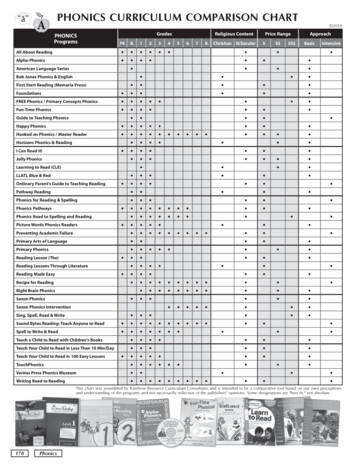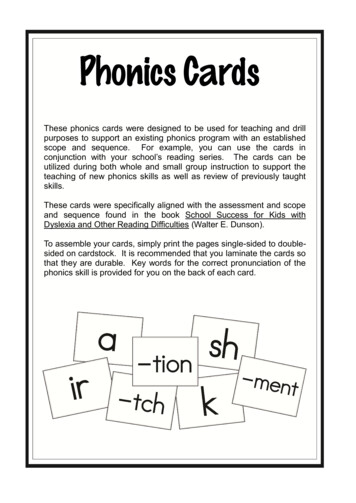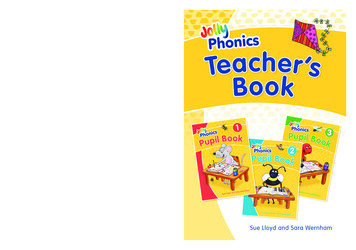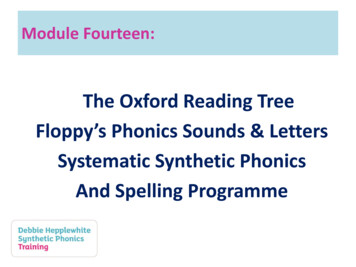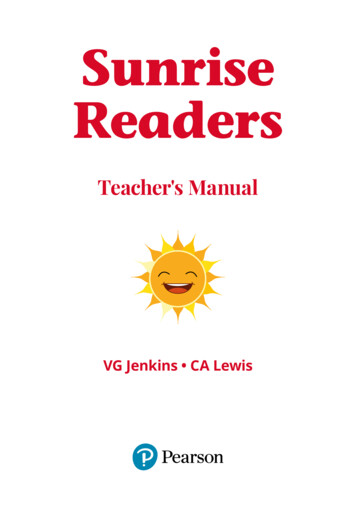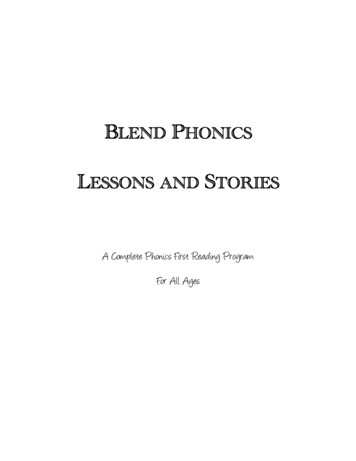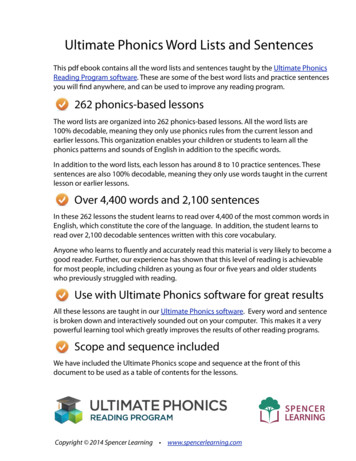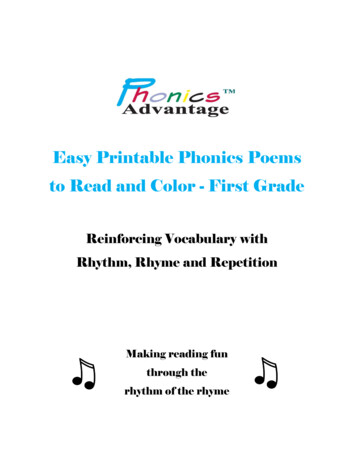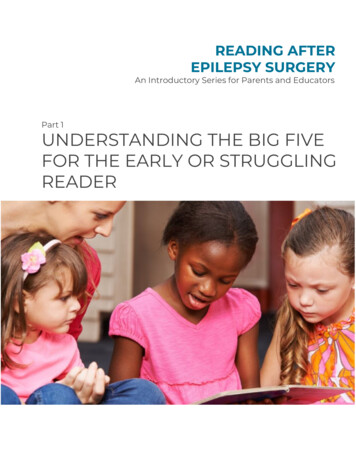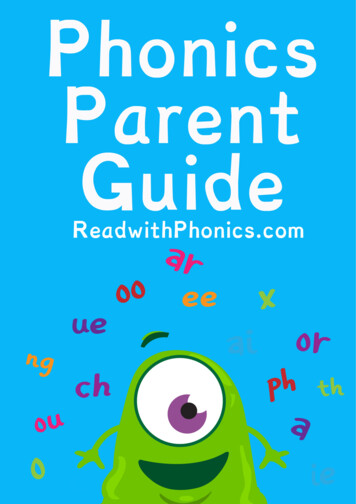
Transcription
Read with Phonics.com
ContentsWhat is phonics?The phonics codebreakerWhat makes phonics the best method for teaching mychild to read?How is phonics taught in schools?Why is reading and learning to read so important?5 tips to help my child fall in love with readingWhat is the Phonics Screening Check? (England)Read with Phonics.comRead with Phonics.com
What is phonics?Let's start at the beginning.Each one of the 26 letters in the alphabet has it's own‘sound'. This is very different to how a letter is ‘said'in the alphabet. For example:‘a' in ‘arrow’Read with Phonics.com
‘b' in ‘bat’.Of course phonics is not that simple! There are morethan 26 sounds in English language, in fact there are 44sounds in total. Some of these sounds are made up of2 or 3 letters. 2 letter sounds are called digraphs andthree letter sounds are called trigraphs.‘ou’ digraph‘ear’ trigraphRead with Phonics.com
It gets a bit more complicated than that too!For example the 'n' sound, like in 'nail' is also spelt‘kn' like in ‘knot’ or ‘gn' like in ‘gnome’.Still with us?! Good!The sound that children struggle to spot the mostwhen decoding words and breaking them down into itssounds is the 'split digraph'. This is when two letterswork together to make one sound, however they aresplit by having a separate letter in the middle.Fortunately ‘split digraphs' always end in an ‘e' whichdoes make them a little easier to spot!Examples of split digraphs include:Read with Phonics.com
So that's it! We appreciate there has been a few newwords thrown at you there that you may have neverheard of, so below is a little phonics codebreaker tohelp us out before we go any further!Read with Phonics.com
Phonics codebreakerPhoneme - a sound as it is saidGrapheme - a sound that is writtenDigraph- two letters that work together to make thesame soundTrigraph - Three letters that work together to makethe same soundSplit digraph - Two letters that work together to makethe same sound, separated by another letterRead with Phonics.com
Why is phonics the best method for teaching mychild to ucially gets children reading quicker. This helps ldrenloveofmemorisingareinsteadtaught a phonics ‘code’.This code helps children work out how to read 95% ofthe English language.If you didn't learn to read cept of words being made upof just 44 sounds is gressintheir reading.Read with Phonics.com
How is phonics taught in schools?Children start to learn to read as soon as they startschool at the age of 5. However, many children entorecognise and differentiate between different listen to sounds that you can hear, such as the soundsthat animals make, or sounds you hear when you gooutside.Read with Phonics.com
Asschoolingprogresseschildrenarethentaughtsimple, single letter sounds from the alphabet, beforemoving on to learning about digraphs, trigraphs andsplit digraphs or long vowel sounds.Phonics is often used in listening and writing lessonsas well reading lessons. Often for example, children inschools are taught and encouraged to spell understanding of how words are made up of sounds,and that different letters make certain achandsoundsthrough multi sensory activities such assinging or dancing or by playing games,both physical and online. All asvitalthatvariedaspossible.Practising sounds as they are taught Read with Phonics.commaintheir
reading. From my experience, children who are eitherread to at home, or read at home themselves, even forjustafewminutesaweek,makereallyimprovements compared to those who do not.Read with Phonics.comnoticeable
Whyisreadingandlearningtoreadsoimportant?Reading is one of the first things that children learnwhen they start school. It is the foundation of alleducation. When children can read, other subjects thenbecome available to them and independent learning canbegin. Those who are unable to read well will findthemselves at a constant disadvantage throughout nefitsbutsocial ones as well. Reading with your child can be oneof the most exciting, memorable and special times foryou as a parent. It is not everyday you can help teachyour child a skill they will use every single day for therest of their dependence and self belief that will massively helpyour child's all round development.Read with Phonics.com
5 tips to help your child fall in love with sted in.This may sound obvious, but asking a child to readabout robots if they love trains isn't going to have thesame impact!2.Pick a quiet and appropriate time to readCreating a relaxed environment can really help to easethe pressure some children face when asked to practicetheir reading.3.Talk about the storyIt is important to make reading morethan just about 'practicing reading'.Remember that books are stories!Talk about what is happening in thestory 'what do you think this bookis going to be about?' 'What do youthink will happen next?' are greatquestionstoengageyourchildinthe storybook.Read with Phonics.com
4.Identify tricky words first before you start readingOnce you start to read regularly you will learn thewords that they will find tricky depending on theirlevel. Reading the trickier words together before youstart reading will give your child confidence when theysee that word during the story.5.Give them time to decipher the wordsGiving your child time to decipher the words and rtant for children to learn the process of how toread words. That is how phonics works. Ask them e patient here! It is not uncommon for children tocorrectly read a word and then 30 seconds later beunable to read it. Go through the process from thebeginning, sound it out, blend it together and in timethey will recognise high frequency Read with Phonics.comfortheir
What is Phonics Screening check essment that all children in Year 1 in England musttake. It is used to assess a students phonic decodingskills. To pass a student must correctly read around32/40 words ewordaresplitintostructureswords with five or six letters.Read with Phonics.comtosectionstrickier
The often confusing thing about the screening check isthat 20/40 of the words that children are expected toread are ‘nonsense words’, alien words that have nomeaning. This is so that the check test a child's nsure they don't just know the word in the check bymemory. The aim of the check is to ensure childrenhave the skills they need to learn new words in thefuture.Read with Phonics.com
yourchild’sscreeningteacherweek.Thewords are the same all across the country. Schools aresent the screening check through the post in a sealedbox and teachers are not allowed to open the testuntil the start of that week. Your child will be scoredagainst a national average which has been 32 since2012. The mark will be told to schools at the end ual children’s results will not be published.Perhaps the most important thing to take away fromall this is to not stress out, and certainly don’t letyour child feel anxious about the check in anyway. Ifyour child can read, this check is easy.Read with Phonics.com
Read with Phonics is made by teachers to help childrenlearn to read through the method of phonics. Eachgame reinforces the method of phonics by sounding outand blending every word used. Together with roommethods of teaching into fun, interactive games thatcan compliment any phonics program used in schools.Play online or on a tablet, Read with Phonics is freeto download on iOS, Android and Amazon.Read with Phonics.com
Read with Phonics.com
graphics, Read with Phonics incorporates classroom methods of teaching into fun, interactive games that can compliment any phonics program used in schools. Play online or on a tablet, Read with Phonics is free to download on iOS, A
